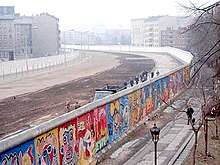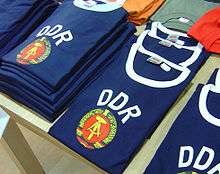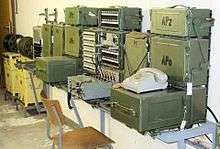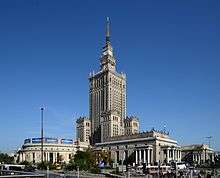Cold War Europe
From the end of World War II in 1945 until the revolutions of the 1980s, Europe was divided between two political blocs; east and west. The border was figuratively called the Iron Curtain, and is to some extent visible today, through former military and border security installations across the continent.
- See also: European history
Understand
| “ | From Stettin in the Baltic to Trieste in the Adriatic, an iron curtain has descended across the Continent. | ” |
—Winston Churchill, 1946 | ||


While the war and necessity had bound the Soviet Union, the United States, the United Kingdom and later free France into an uneasy alliance, the lack of a common enemy after the war and different ideologies triggered a break between the Soviet Union on one side and the "Western allies" on the other. This break not only affected the politics between those countries, but also the treatment of the defeated axis members and some neutral countries who had held sympathy for either side. While all four allies initially agreed to try the main war criminals in Nuremberg and "jointly" administer occupied Germany and Austria, the facade of a joint administration began crumbling as early as 1948, when Stalin decided to blockade West Berlin and the British and Americans organized an airlift to break the blockade. Eventually, the former Axis nations were absorbed into the Western bloc and NATO (West Germany, Italy, Japan) or the Warsaw pact (East Germany, Hungary, Romania, etc). The United States and the Soviet Union emerged as the two superpowers of the era, and often challenged each other for world domination in a variety of areas such as military power and technological innovation. Although the two superpowers never actually went to war with each other, both sides often supported various proxy wars between their respective allies in an effort to spread their influence.
One of the most notable events of the early years of the Cold War besides the airlift was the Marshall Plan that was supposed to provide aid in the rebuilding of Europe and was soundly rejected by the Eastern Bloc countries. Much of the architecture of the 1950s (now mostly regarded as rather ugly) was built with funds from the Marshall Plan, whereas the Soviet Union popularized its own style that can still be seen in cities like East Berlin (especially Karl Marx Allee), Eisenhüttenstadt, Warsaw or Budapest.
The 1950s and 1960s saw unprecedented economic growth in most of Europe, especially West Germany, where the period came to be known as the Wirtschaftswunder ("economic miracle"). From the 1970s, relationships across the Iron Curtain improved, with Ostpolitik implemented by West German chancellor Willy Brandt.
Starting around the 1970s, the need for cheap housing led to a construction boom of a particular type of mass produced pre-fabricated housing. While those residential buildings got a different name in almost every country they were built in (Plattenbau being the German term), they were mostly the same everywhere and were also built in the West to a certain extent. Even though they were regarded as ultimately modern and innovations like central heating or direct road/public transport access made them popular at the time of their building, they have become negatively associated with socialism since 1990 and entered a decline in both perceived value and prestige. However, in some places efforts by local government to revitalize those neighborhoods show some signs of success and even early signs of gentrification can be observed in certain such neighborhoods.
Especially the 60s and 70s were marked by counterculture and pop culture. A lasting expression was the rise of British pop music.
Finland had an unusual history during the cold war, as - in the words of a political cartoonist - they wished to "bow to the East without mooning the West". Amazingly, they managed to maintain a democratic, multi-party free market economy on good terms with the West without offending the East. All that despite the fact that Finland had fought two separate wars against the Soviet Union between 1939 and 1945 and had been a de facto ally of Nazi Germany in one of them.
The Soviet Union and Eastern Europe had become weakened by the 1980s, and civil rights protests brought down many Communist governments. Since then, most European nations east of the Iron Curtain have become democratic market economies. The Soviet Union itself collapsed in 1991, and fragmented into 15 different countries, of which Russia is the largest and most influential. Since the collapse of the Soviet Union, the United States has been the world's sole superpower, though in recent times, its hegemony is increasingly being challenged by a resurgent China and Russia.
Throughout the Cold War, the great powers had to prepare for a future conflict, prospectively named the third World War. Especially along the Iron Curtain, bunkers, bomb shelters and missile sites can be found.
This war never happened, and post-1945 Europe has been remarkably peaceful, with the exception of regional conflicts in the Basque Country, Corsica and Northern Ireland. Peace was broken in Yugoslavia in 1991, where a lengthy series of wars went on until 1999. As of the 2010s, the main line of conflict is between Russia and the European Union, with armed conflict going on in eastern Ukraine.

Heritage
| “ | The end of the Cold War is our common victory. | ” |
—Mikhail Gorbachev, last leader of the Soviet Union | ||
The German word Ostalgie describes the nostalgia for East Germany and other socialist states. Some icons, such as the Ampelmännchen pedestrian signal, have a cult following. In the Balkans there is a certain amount of "Yugo-nostalgia" for things associated with former Yugoslavia. Today many products that used to be available in the eastern bloc are once again available, though they are not always 100% authentic and may be produced by companies that have nothing to do with their erstwhile manufacturers. Ironically sometimes what used to be cost cutting measures to avoid using too much hard currency is now sometimes used as a selling point. For instance Nudossi, the erstwhile East German hazelnut-chocolate spread has a lot more nuts and less cacao than its western counterparts – today this is not hidden somewhere on the ingredient label but proudly displayed in advertising as a feature of quality.
Destinations
- See Soviet Union for eastern destinations.
Bulgaria
- 🌍 Buzludzha (Бузлуджа) (near Shipka / the Bulgarka Nature Park). Built between 1974 and 1981 to commemorate the pioneer Bulgarian communists, who used to meet in this remote summit of the Balkan Mountains, the truly out-of-place Buzludzha Monument is often likened to a UFO landed on a mountaintop, due to its kind of "socialist futurist" architecture. Abandoned at the end of the communism in the country, Buzludzha and its slowly waning socialist realist art inside out attract a certain number of urbexers.
Croatia
What was then Yugoslavia emerged as a communist country after World War II in which Tito and his communists were one, but by no means the only force fighting the Nazis in the Balkans. Stalin provided support to Tito and the two considered each other allies, but by the end of the 1940s a rift had occurred, mostly over foreign policy.
Stalin and other leaders denounced Tito while Tito had Stalinists imprisoned at 🌍 Goli Otok of the Coast of what's now Croatia. Later on, when tensions subsided the prison island increasingly came to house "normal" prisoners.
Czech Republic
Denmark
Denmark was relatively unharmed by the war. The country was a founding member of NATO and the United Nations, and integrated quickly into the Western Bloc.
- 🌍 Stevnsfort Cold War Museum (Koldkrigsmuseum Stevnsfort) (Stevns Cliff). A coastal fortress dug into the limestone cliff, which played an important role in the cold war defense of Denmark and NATO.
- 🌍 Museum of the Cold War Langelandsfort (Langeland). Off-the-beaten-path museum in the 1950s fortress of the Danish naval defence offers a great self-guided tour through bunkers, anti-aircraft gun, submarine, minesweeper, fighter planes, and more.
- 🌍 Odense bunker museum. A small museum in a bunker, previously a nuclear-secure central command post for Odense.
Finland
Between 1944 and 1956 the parts of the Uusimaa area in Southern Finland at and around Porkkala peninsula were leased to the Soviet Union as a naval base. The Soviet lease for Porkkala had been contracted for 50 years originally, however in 1955 an agreement was reached to return it earlier. There are still traces of the Soviet lease period to be seen in Ingå. A natural start of the exploration can be the Igor Museum in Degerby.
Finland had a key role in the 1975 Conference on Security and Co-operation in Europe (the "Helsinki process"), which later developed into OSCE. The conference was important in allowing talks and reducing tension across the Iron Curtain. At the time, the Helsinki accords were seen as a significant win for the Eastern Bloc, as the existing borders and societal systems were practically agreed to as inviolable by both sides - something which had been a sticking point with regards to many post-war borders and attempts at "rollback" by the US. However, as it turned out over the years, the sections about human rights, dismissed as mere window dressing at the time, proved incredibly important and there was nary an oppositional group in the USSR's sphere of influence that didn't invoke the word "Helsinki" or raise a fuzz in Western media when repression came down too hard upon them.
- 🌍 Igor Museum in Degerby, Ingå, Furuborgintie 6, 10160 Degerby, ☎ +358 40-541-8526, e-mail: igor@degerby.fi. 1.6-17.8 Tu- Sa 11:00-16:00, in winter Sa 12:00-16:00 and other times by agreement. Stories of Finnish and Soviet people affected by involuntary re-settling due to the Porkkala lease. 5 €.
Germany

The Allies divided Germany between them, initially forming four occupation zones (Soviet, French, American and British) and later establishing the Federal Republic of Germany (West Germany; on the territory of the French, British and American occupation zones), and the German Democratic Republic (East Germany; on the territory of the Soviet occupation zone and the Soviet sector of Berlin). Berlin was de jure under the "joint administration" of all four allies, but de facto an enclave within East Germany (American, French and British sectors) and the capital of the GDR (Soviet sector) respectively
- 🌍 Berlin. Berlin symbolizes the Cold War more than any other city. The Berlin Wall was erected in 1961, and most of it was torn down in the 1989 revolution. Bits and pieces of it have been sold around the world and you can still buy postcards with an "original" piece of Berlin Wall in it. However, some parts were deliberately left standing or re-erected at certain sites to serve as memorials or art installations. The DDR Museum in Berlin/Mitte gives insight into the daily lives of people in the former German Democratic Republic (East Germany). The Tränenpalast (Palace of Tears, former scene of many tearful goodbyes at Friedrichstraße railway station in East Berlin) also became a museum.
- 🌍 Leipzig. Leipzig was the second-biggest city in East Germany and one of the origins of the 1989 Peaceful Revolution. Several monuments and museums remind of the Cold War Era: There is a museum in the former Stasi branch, vividly illustrating the sometimes perfidious, sometimes banal work of the East German secret police; the Zeitgeschichtliches Forum ("Forum of Contemporary history"; being one of two sites of the German government-funded "House of History", the other is in Bonn) features a comprehensive and very illustrative permanent exhibition on the German partition, revolution and reunification (free admission); the GDR's last active place of execution has been transformed into a memorial which is however only sporadically opened to public; the St Nicholas' church (Nikolaikirche) with its Peace prayers was where the weekly Monday demonstrations started from, that eventually led to the fall of the Communist regime. Finally, you may visit a former Stasi bunker 30 km east of Leipzig.
- 🌍 Potsdam. The site of the Potsdam Conference where the Allied powers of World War II decided upon the demarcation of their zones of interest, thereby creating the Iron Curtain between East and West. Later, the park came to contain a KGB prison. The Glienicke Bridge between Postdam and West Berlin was a famous site for the exchange of captured secret agents, therefore known as the Bridge of Spies.
- The Ruhr area was the industrial powerhouse of West Germany. Though damaged during World War II, and partly dismantled after the war, the Ruhr fueled the West German economic miracle, until the manufacturing crisis of the 1970s. Many closed mines and industries remain as museums.
- 🌍 Bautzen. The very name still makes some Easterners shudder, as Bautzen was the site of a notorious prison run by the Staatssicherheit or Stasi of East Germany and the place where most political prisoners ended up, many being "sold" to West Germany for what can only be called ransom money. The former prison has been turned into a memorial and can be visited in guided tours, guided by former inmates on certain occasions.
- 🌍 Bonn. Bonn was the de facto capital of West Germany from 1949 to 1990/1998. As it was seen as a provisional solution by most politicians, former government buildings in the city don't look all that impressive. The Bundestag decided on reunification while seated in a former water supply plant, for instance. Ironically many buildings were either upgraded or replaced in the 1980s when it seemed as if the temporary solution would become a permanent one. Today some of the former government buildings have been turned into museums and can be visited - including the former residence of the Chancellor.
Former inner-German border
Few border installation survive to this day, but there are two extensive memorials with original border wall in situ. One is near 🌍 Hötensleben in Saxony Anhalt, which is run in conjunction with a museum in Marienborn, which used to serve as a border crossing point. Marienborn was the eastern side, while Helmstedt was the Western side. The other is at the 🌍 Mödlareuth village, which is partly in Franconia and partly in Thuringia, therefore divided by a wall and nicknamed "Little Berlin".
Hungary
- 🌍 Budapest. The Hungarian capital saw the bulk of the fighting in the Hungarian Uprising of 1956. The earliest major revolt against the Soviet control of Eastern Europe, the event is commemorated by a contemporary monument on Dózsa György út near the City Park (Városliget), which was the site of a Stalin statue before it was toppled by the demonstrators during the uprising. Nearby House of Terror on Andrassy utca, once the headquarters of the Hungarian version of KGB, exhibits the excesses of the socialist system, how it affected daily lives, and the propaganda associated with it in a deeply emotional way — the reconstructed internment cells at the basement are especially depressing. For a less distressing experience, head to Szoborpark in the countryside just out of Újbuda, which has a collection of socialist-era statues removed from Budapest and all over the country after the democracy was restored, and where you can try fitting inside a Trabant, the quintessential socialist car produced in East Germany.
Lithuania
- 🌍 Plokštinė missile base. Plokštinė missile base (Lithuanian: Plokštinės raketų bazė) was the first underground missile base of the Soviet Union, constructed in early 1960s. Today it is open for visitors as a Cold War Museum, installed in one of the four existing silos.
Poland

Romania
- 🌍 Parliament Palace (Palatul Parliamentului), Strada Izvor 2-4 (near Piaţa Unirii (Union Plazza) in Bucharest - M1, 3 'Izvor' - entrance is on the north side), ☎ +40 21 3160300. The world's second largest building (after the US Pentagon), formerly named "Casa Poporului" (People's House). The building, which was built in 1984 on orders of Nicolae Ceauşescu, spans 12 stories, 3100 rooms and covers over 330,000 sq m. 1/9 of Bucharest was reconstructed to accommodate this magnificent massive building and its surroundings. There are 30-45 minute tours every half hour which lead through the building's vast collection of marble rooms and culminates in an impressive view from Nicolae Ceauşescu's balcony. The marble and all the original decorations are 100% from Romania. The basic tour includes the halls and the balcony, worthwhile is the terrace addition for the wonderful view from the top of the building. The basement addition on the other hand is not worth the money. They only show two rooms containing air ducts, no additional facts and it lasts only 5 minutes. Different Tours ranging in price from 25 lei (15 lei for students, proof required) up to 43 lei.
Sweden
Sweden managed to stay out of both world wars, and formally had a non-alignment policy through the Cold War, defending itself with a world-class airforce, extensive conscription, and even a nuclear weapons programme which was just a few ounces of plutonium short from a finished bomb.
- 🌍 Swedish Air Force Museum (Linköping). Sweden was officially non-aligned during the Cold War, though they had secret contingency plans with NATO. Though a country with a small population, Sweden maintained a world-leading air force, with many aircraft developed at SAAB in Linköping. The Air Force Museum features many of these planes, as well as an exhibition about the preparations for a war that never came.
- 🌍 Femöre Fort (Femörefortet) (Oxelösund). A coastal fortress with an extensive Cold War museum.
United Kingdom
- 🌍 Kelvedon Hatch Secret Nuclear Bunker (near Braintree (Essex). Access is from the A128 Chipping Ongar to Brentwood road at Kelvedon Hatch. If you have GPS then use CM15 0LA), ☎ +44 1277 364883, fax: +44 1277 372562, e-mail: bunker@japer.demon.co.uk. 10AM-4PM. £6.50 Adults, £4.50 children 5-16 inc.
Itineraries
The Iron Curtain Trail (EuroVelo 13) is a projected, 7650 km long themed cycle route, leading along the former border between Eastern and Western blocs from Kirkenes on the northernmost point of the Norwegian-Russian border to the Bulgarian-Turkish border at the Black Sea, passing many Cold War-era memorials and other points of interest.
See also
- James Bond tourism; the Cold War from a fictional point of view.
- The Orient Express held a certain Cold War intrigue as it crossed behind the Iron Curtain and back to reach Istanbul.
- Korean War; the first major Cold War conflict
- Indochina Wars; a parallel series of conflicts in Southeast Asia
- North Korea - often called the last remnant of the cold war and certainly an interesting example of a cult of personality
- Nuclear tourism
- Post-war United States
- Transnistria is still governed by a supreme Soviet - albeit a democratically elected one.